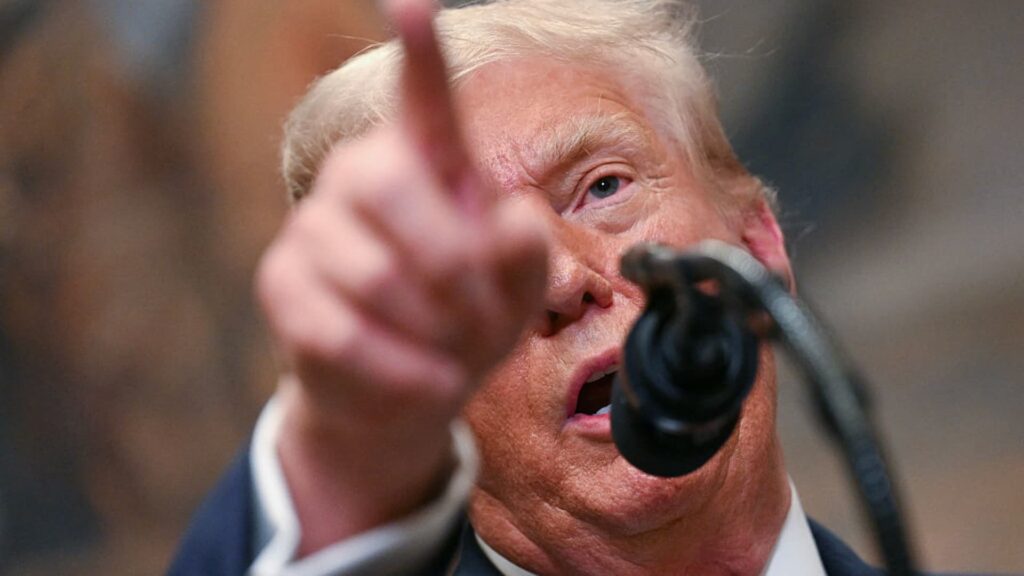U.S. President Donald Trump after signing an executive order restarting the Presidential Fitness Test in public schools in the Roosevelt Room of the White House in Washington, D.C., on July 31, 2025.
Jim Watson | AFP | Getty Images
The first time U.S. President Donald Trump unveiled his “reciprocal” tariffs on the rest of the world, the April 2 event had a cinematic, even grand, quality. It took place at the White House Rose Garden. There was a live band playing, according to The Wall Street Journal. Trump hoisted huge physical charts of his tariff rates, which were helpfully color-coded for visual clarity.
This time, Trump’s updated “reciprocal” tariffs, released the night before they come into effect on Aug. 1, seemed in comparison stripped of pomp and glamor. The White House’s executive order popped up around 7 p.m. ET, just as people in the U.S. were getting off work. There was no live event, no big chart and certainly no entertainment — just a stern website with a black-and-white table.
That austerity — and, one might even say, stealth — surrounding the recent announcement suggests two things.
First, the White House could be aware that the dramatic shock of tariffs has less power to sway trade deals when staged a second time. The “90 deals in 90 days” that trade advisor Peter Navarro had promised in April are, after all, nowhere in sight. Trump, however, still left ajar the door to making “some kind of a deal.”
Second, the U.S. might actually be pleased with the effects of its higher-than-expected tariffs on countries without deals, and is willing to keep levies at those levels. In June, the U.S. Treasury Department reported an unexpected surplus thanks to tariff revenue, which were more than four times higher from a year ago. And economists aren’t as alarmed by tariff-driven inflation as they once were.
All that’s speculation, of course. The order could have been released in this low-key fashion simply because the Rose Garden is now more like a Concrete Path. Or perhaps Trump doesn’t want the penguins on the Heard and McDonald islands to hear about his levies this time.
What you need to know today
The U.S. rejigs tariff rates ahead of Aug. 1 deadline. Trump’s executive order also imposed a 40% duty on all goods considered to have been transshipped to America. Here’s how Asian leaders are reacting to the announcement, made Thursday evening stateside.
The S&P 500 falls, retreating from an intraday high. Microsoft shares, however, rose around 4% to push the company’s market cap above $4 trillion. Asia-Pacific markets — and tech giants, in particular — fell on Friday as investors digest latest tariff developments.
Apple beats expectations for profit and revenue. The Cupertino-based company’s iPhone sales grew 13% year over year, while overall revenue rose 10% in its fiscal third quarter, the fastest growth since December 2021.
Amazon’s gloomy guidance overshadows its earnings. Even though the company surpassed Wall Street’s estimates for its second-quarter results, its expected operating income for the current quarter wasn’t as high as analysts had hoped for.
[PRO] Novo Nordisk’s stock plunge isn’t that surprising. On Tuesday, the firm’s shares fell as much as 26% after it slashed its full-year guidance — and appointed a new CEO. Here’s why companies tend to make both announcements simultaneously.
And finally…
Technicians work on the assembly line for Rolls-Royce Cullinan and Spectre vehicles at Rolls-Royce Motor Cars’ manufacturing plant in Goodwood, near Chichester, Britain, May 28, 2025.
Carlos Jasso | Reuters
Tariff turmoil: How global CEOs are shifting gears
In interviews with CNBC this earnings season, CEOs across industries sent a clear message: tariffs are no longer just a political tactic.
As trade rules grow more uncertain and tariffs resurface in policy discussions, business leaders say they’re rethinking everything from where factories are located to how products are priced. The old “just in time” model is giving way to something more cautious: make goods closer to the buyer, ask for exemptions where possible, and stay alert to shifting consumer habits.
— Spriha Srivastava

